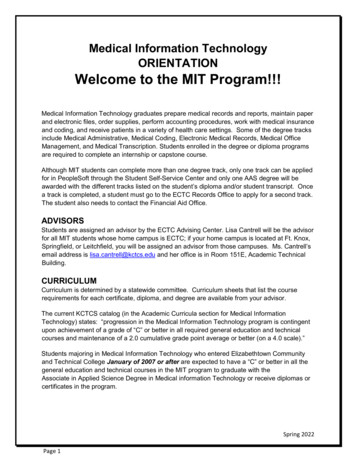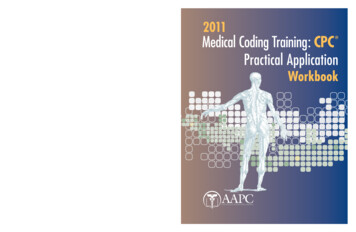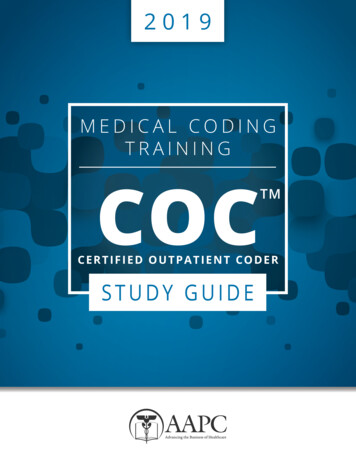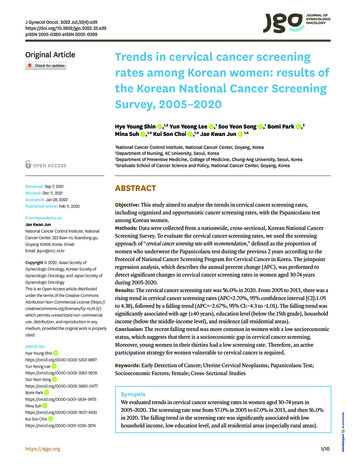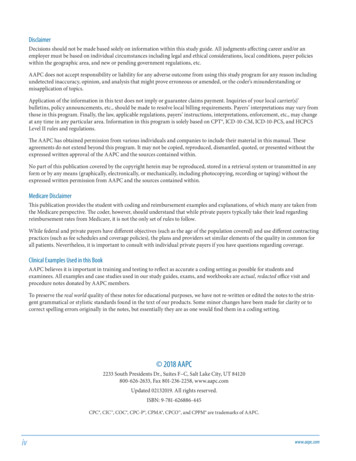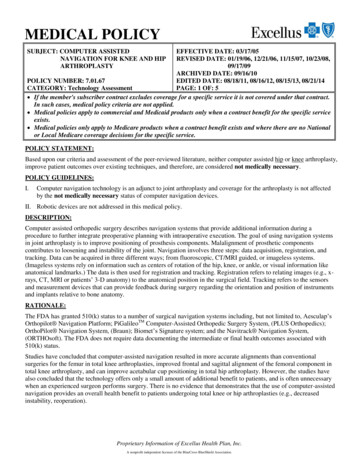
Transcription
MEDICAL POLICYSUBJECT: COMPUTER ASSISTEDNAVIGATION FOR KNEE AND HIPARTHROPLASTYEFFECTIVE DATE: 03/17/05REVISED DATE: 01/19/06, 12/21/06, 11/15/07, 10/23/08,09/17/09ARCHIVED DATE: 09/16/10POLICY NUMBER: 7.01.67EDITED DATE: 08/18/11, 08/16/12, 08/15/13, 08/21/14CATEGORY: Technology AssessmentPAGE: 1 OF: 5 If the member's subscriber contract excludes coverage for a specific service it is not covered under that contract.In such cases, medical policy criteria are not applied. Medical policies apply to commercial and Medicaid products only when a contract benefit for the specific serviceexists. Medical policies only apply to Medicare products when a contract benefit exists and where there are no Nationalor Local Medicare coverage decisions for the specific service.POLICY STATEMENT:Based upon our criteria and assessment of the peer-reviewed literature, neither computer assisted hip or knee arthroplasty,improve patient outcomes over existing techniques, and therefore, are considered not medically necessary.POLICY GUIDELINES:I.Computer navigation technology is an adjunct to joint arthroplasty and coverage for the arthroplasty is not affectedby the not medically necessary status of computer navigation devices.II. Robotic devices are not addressed in this medical policy.DESCRIPTION:Computer assisted orthopedic surgery describes navigation systems that provide additional information during aprocedure to further integrate preoperative planning with intraoperative execution. The goal of using navigation systemsin joint arthroplasty is to improve positioning of prosthesis components. Malalignment of prosthetic componentscontributes to loosening and instability of the joint. Navigation involves three steps: data acquisition, registration, andtracking. Data can be acquired in three different ways; from fluoroscopic, CT/MRI guided, or imageless systems.(Imageless systems rely on information such as centers of rotation of the hip, knee, or ankle, or visual information likeanatomical landmarks.) The data is then used for registration and tracking. Registration refers to relating images (e.g., xrays, CT, MRI or patients’ 3-D anatomy) to the anatomical position in the surgical field. Tracking refers to the sensorsand measurement devices that can provide feedback during surgery regarding the orientation and position of instrumentsand implants relative to bone anatomy.RATIONALE:The FDA has granted 510(k) status to a number of surgical navigation systems including, but not limited to, Aesculap’sOrthopilot Navigation Platform; PiGalileoTM Computer-Assisted Orthopedic Surgery System, (PLUS Orthopedics);OrthoPilot Navigation System, (Braun); Biomet’s Signature system; and the Navitrack Navigation System,(ORTHOsoft). The FDA does not require data documenting the intermediate or final health outcomes associated with510(k) status.Studies have concluded that computer-assisted navigation resulted in more accurate alignments than conventionalsurgeries for the femur in total knee arthroplasties, improved frontal and sagittal alignment of the femoral component intotal knee arthroplasty, and can improve acetabular cup positioning in total hip arthroplasty. However, the studies havealso concluded that the technology offers only a small amount of additional benefit to patients, and is often unnecessarywhen an experienced surgeon performs surgery. There is no evidence that demonstrates that the use of computer-assistednavigation provides an overall health benefit to patients undergoing total knee or hip arthroplasties (e.g., decreasedinstability, reoperation).Proprietary Information of Excellus Health Plan, Inc.A nonprofit independent licensee of the BlueCross BlueShield Association.
SUBJECT: COMPUTER ASSISTEDNAVIGATION FOR KNEE AND HIPARTHROPLASTYPOLICY NUMBER: 7.01.67CATEGORY: Technology AssessmentCODES:NumberEFFECTIVE DATE: 03/17/05REVISED DATE: 01/19/06, 12/21/06, 11/15/07, 10/23/08,09/17/09ARCHIVED DATE: 09/16/10EDITED DATE: 08/18/11, 08/16/12, 08/15/13, 08/21/14PAGE: 2 OF: 5DescriptionEligibility for reimbursement is based upon the benefits set forth in the member’s subscriber contract.CODES MAY NOT BE COVERED UNDER ALL CIRCUMSTANCES. PLEASE READ THE POLICY ANDGUIDELINES STATEMENTS CAREFULLY.Codes may not be all inclusive as the AMA and CMS code updates may occur more frequently than policy updates.Code Key: Experimental/Investigational (E/I), Not medically necessary/ appropriate (NMN).CPT:20985 (NMN)Computer-assisted surgical navigational procedure for musculoskeletal procedures;image-less (List separately in addition to code for primary procedure)0054T (NMN)Computer-assisted musculoskeletal surgical navigational orthopedic procedure, withimage guidance based on fluoroscopic images (List separately in addition to code forprimary procedure)0055T (NMN)Computer-assisted musculoskeletal surgical navigational orthopedic procedure, withimage guidance based on CT/MRI images (List separately in addition to code forprimary procedure)Copyright 2014 American Medical Association, Chicago, ILHCPCS:No codesICD9:Not medically necessary for all codesICD10:Not medically necessary for all codes.REFERENCES:American Association of Hip and Knee Surgeons. Position statement on computer assisted orthopaedic surgery (COAS)for total hip and knee replacement. [www.aahks.org] accessed 7/24/13.*Amiot LP, et al. Computed tomography-based navigation for hip, knee, and spine surgery. Clin Orthopaed Rel Res 2004Apr;(421)77-86.Anderson KC, et al. Computer assisted navigation in total knee arthroplasty. J Arthroplasty 2005 Oct;20(7)Supp 3:132-8.Bauwens K, et al. Navigated total knee replacement. A meta-analysis. J Bone Joint Surg Am 2007 Feb;89(2):261-9.Beckmann J, et al. Navigated cup implantation in hip arthroplasty. Acta Ortho 2009 Oct;80(5):538-44.Biasca N, et al. Minimally invasive computer-navigated total knee arthroplasty. Orthop Clin North Am 2009Oct;40(4):537-63.BlueCross BlueShield Association. Computer-assisted musculoskeletal surgical navigational orthopedic procedure.Medical Policy Reference Manual Policy #7.01.96. 2014 July 10.BlueCross BlueShield Association. Technology Evaluation Center (TEC) Assessment Program. Computer assistednavigation for total knee arthroplasty. 2007 Oct 26;23:1-44.Browne JA, et al. Postoperative morbidity and mortality following total knee arthroplasty with computer navigation.Knee 2010 Mar;17(2):152-6.*Chauhan SK, et al. Computer-assisted knee arthroplasty versus a conventional jig-based technique - a randomised,prospective trial. J Bone Joint Surg Br 2004 Apr;86-B:372-7.Choong PF, et al. Does accurate anatomical alignment result in better function and quality of life? Comparingconventional and computer-assisted total knee arthroplasty. J Arthroplasty 2009 Jun;24(4):560-9.Proprietary Information of Excellus Health Plan, Inc.
SUBJECT: COMPUTER ASSISTEDNAVIGATION FOR KNEE AND HIPARTHROPLASTYPOLICY NUMBER: 7.01.67CATEGORY: Technology AssessmentEFFECTIVE DATE: 03/17/05REVISED DATE: 01/19/06, 12/21/06, 11/15/07, 10/23/08,09/17/09ARCHIVED DATE: 09/16/10EDITED DATE: 08/18/11, 08/16/12, 08/15/13, 08/21/14PAGE: 3 OF: 5Confalonieri N, et al. Computer-assisted technique versus intramedullary and extramedullary alignment systems in totalknee replacement: a radiological comparison. Acta Orthop Belg 2005 Dec;71(6)703-9.Dutton AQ, et al. Computer-assisted minimally invasive total knee arthroplasty compared with standard total kneearthroplasty. A prospective, randomized study. J Bone Joint Surg Am 2008 Jan;90(1):2-9.Dutton AQ, et al. Computer-assisted minimally invasive total knee arthroplasty compared with standard total kneearthroplasty. Surgical technique. J Bone Joint Surg Am 2009 Mar 1;91 Suppl 2 Pt 1:116-30.Ensini A, et al. Alignments and clinical results in conventional and navigated total knee arthroplasty. Clin Orthop RelatRes 2007 Apr;457:156-62.Ghandi R, et al. Computer navigation in total hip replacement: a meta-analysis. Int Orthop 2009 Jun;33(3):593-7.*Grützner PA, et al C-arm based navigation in total hip arthroplasty-background and clinical experience. Injury2004;35:S-A90-5.Haaker RG, et al. Computer-assisted navigation increases precision of component placement in total knee arthroplasty.Clin Ortho Rel Res 2005 Apr;433:152-9.Han SB, et al. The reliability of navigation-guided gap technique in total knee arthroplasty. Orthopedics 2008 Oct;31(10Suppl 1).Hart R, et al. Outcomes after conventional versus computer-navigated anterior cruciate ligament reconstruction.Arthroscopy 2008 May;24(5):569-78.Hinarejos P, et al. Computer-assisted surgery can reduce blood loss after total knee arthroplasty. Knee Surg SportsTraumatol Arthrosc 2009 Mar;17(2):356-60.Hsieh PH, et al. Image-guided periacetabular osteotomy: computer-assisted navigation compared with the conventionaltechnique: a randomized study of 36 patients followed for 2 years. Acta Orthop 2006 Aug;77(4):591-7.Kalairajah Y, et al. Are systemic emboli reduced in computer-assisted knee surgery? A prospective, randomized, clinicaltrial. J Bone Joint Surg (Br) 2006 Feb;88-B(2):198-202.Kamat YD, et al. Does computer navigation in total knee arthroplasty improve patient outcome at midterm follow-up? IntOrthop 2009 Dec;33(6):1567-70.Kendoff D, et al. Surgical navigation in knee ligament reconstruction. Clin Sports Med 2009 Jan;28(1):41-50.Kim SJ, et al. Computer navigation in total knee arthroplasty. J Arthroplasty 2005 Oct;20(7)Suppl 3:123-31.Kim YH, et al. Computer-assisted surgical navigation does not improve the alignment and orientation of the componentsin total knee arthroplasty. J Bone Joint Surg Am 2009 Jan;91(1):14-9.Liebergall M, et al. Computerized navigation for the internal fixation of femoral neck fractures. J Bone Joint Surg Am2006 Aug;88(8):1748-54.Lim MH, et al. Comparative study of the use of computer assisted navigation system for axial correction in medialunicompartmental knee arthroplasty. Knee Surg Sports Traumatol Arthrosc 2009 Apr;17(4):341-6.Luring C, et al. Minimal invasive and computer assisted total knee replacement compared with the conventionaltechnique: a prospective, randomized trial. Knee Surg Sports Traumatol Arthrosc 2008 Oct;16(10):928-34.Luring C, et al. Two-year follow-up comparing computer assisted versus freehand TKR on joint stability, muscularfunction and patients satisfactions. Knee Surg Sports Traumatol Arthrosc 2009 Mar;17(3):228-32.Lutzner J, et al. Computer-assisted and conventional total knee replacement: a comparative, prospective, randomizedstudy with radiological and CT evaluation. J Bone Joint Surg Br 2008 Aug;90(8):1039-44.Proprietary Information of Excellus Health Plan, Inc.
SUBJECT: COMPUTER ASSISTEDNAVIGATION FOR KNEE AND HIPARTHROPLASTYPOLICY NUMBER: 7.01.67CATEGORY: Technology AssessmentEFFECTIVE DATE: 03/17/05REVISED DATE: 01/19/06, 12/21/06, 11/15/07, 10/23/08,09/17/09ARCHIVED DATE: 09/16/10EDITED DATE: 08/18/11, 08/16/12, 08/15/13, 08/21/14PAGE: 4 OF: 5Martin A and von Strempel A. Two-year outcomes of computed tomography-based and computed tomography freenavigation for total knee arthroplasties. Clin Orthoped Rel Res 2006 Aug;(449):275-82.Matziolis G, et al. A prospective, randomized study of computer-assisted and conventional total knee arthroplasty. Threedimensional evaluation of implant alignment and rotation. J Bone Joint Surg Am 2007 Feb;89(2):236-43.Mauch F, et al. Differences in the placement of the tibial tunnel during reconstruction of the anterior cruciate ligamentwith and without computer-assisted navigation. Am J Sport Med 2007 Nov;35(11):1824-32.Olsen M, et al. Imageless computer navigation for placement of the femoral component in resurfacing arthroplasty of thehip. J Bone Joint Surg Br 2009 Mar;91(3):310-5.Pang CH, et al. Comparison of total knee arthroplasty using computer-assisted navigation versus conventional guidingsystems: a prospective study. J Orthop Surg 2009 Aug;17(2):170-3.Parratte S, et al. Validation and usefulness of a computer-assisted cup-positioning system in total hip arthroplasty. Aprospective, randomized, controlled study. J Bone Joint Surg Am 2007 Mar;89(3):494-9.Plaweski S, et al. Anterior cruciate ligament reconstruction using navigation: a comparative study on 60 patients. Am JSports Med 2006 Apr;34(4):542-52.Schnurr C, et al. The effect of computer navigation on blood loss and transfusion rate in TKA. Orthopedics 2010 Jul13;33(7).Seon JK, et al. Functional comparison of total knee arthroplasty performed with and without a navigation system. IntOrthop 2009 Aug;33(4):987-90.Seyler TM, et al. Does computer-assisted surgery improve accuracy and decrease the learning curve in hip resurfacing? Aradiographic analysis. J Bone Joint Surg Am 2008 Aug;90 Suppl 3:71-80.*Sikorski JM, Computer-assisted revision total knee replacement. J Bone Joint Surg Br 2004 May;86-B:510-4.*Sparmann M, et al. Positioning of total knee arthroplasty with and without navigation support. JBJS Br 2003 Aug;85B(6):830-5.*Stockl B, et al. Navigation improves accuracy of rotational alignment in total knee arthroplasty. Clin Ortho Rel Res2004 Sep;(426):180-6.*Viceconti M, et al. CT-based surgical planning software improves the accuracy of total hip replacement preoperativeplanning. Med Eng Physics 2003;25:371-7.*Victor J, et al. Image-based computer-assisted total knee arthroplasty leads to lower variability in coronal alignment.Clin Ortho Rel Res 2004 Nov;428:131-9.Zorman D, et al. Computer-assisted total knee arthroplasty: comparative results in a preliminary series of 72 cases. ActaOrthop Belg 2005 Dec;71(6):696-702.Zwingmann J, et al. Computer-navigated iliosacral screw insertion reduces malposition rate and radiation exposure. ClinOrthop Relat Res 2009 Jul;467(7):1833-8.*key articleKEY WORDS:Computer assisted orthopedic surgery, Image guided orthopedic surgery.Proprietary Information of Excellus Health Plan, Inc.
SUBJECT: COMPUTER ASSISTEDNAVIGATION FOR KNEE AND HIPARTHROPLASTYPOLICY NUMBER: 7.01.67CATEGORY: Technology AssessmentEFFECTIVE DATE: 03/17/05REVISED DATE: 01/19/06, 12/21/06, 11/15/07, 10/23/08,09/17/09ARCHIVED DATE: 09/16/10EDITED DATE: 08/18/11, 08/16/12, 08/15/13, 08/21/14PAGE: 5 OF: 5CMS COVERAGE FOR MEDICARE PRODUCT MEMBERSThere is currently a Local Coverage Determination (LCD)/article addressing Category III CPT codes that includescomputer-assisted musculoskeletal surgical navigational orthopedic procedures. Please refer to the following LCD andarticle websites for Medicare Members:http://apps.ngsmedicare.com/lcd/LCD L25275.htmhttp://apps.ngsmedicare.com/sia/ARTICLE A46075.htmProprietary Information of Excellus Health Plan, Inc.
Dutton AQ, et al. Computer-assisted minimally invasive total knee arthroplasty compared with standard total knee arthroplasty. Surgical technique. J Bone Joint Surg Am 2009 Mar 1;91 Suppl 2 Pt 1:116-30. Ensini A, et al. Alignments and clinical results in conventional and navigated total knee arthroplasty. Clin Orthop Relat Res 2007 Apr;457:156-62.


